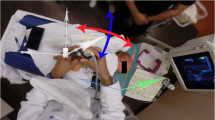Abstract
The purpose of this study was to determine inter-and intra-observer agreement in assessing hip morphology and stability by ultrasound. Three groups of infants, of 206, 74 and 78 newborns respectively, were examined. Morphology was classified into four categories (normal, immature, minor dysplastic and major dysplastic) according to subjective assessment, objective measurement (of the acetabular inclination angle α) or a combination of the two. Inter- and intra-observer agreement was determined for reading of recorded ultrasound scans, and for examination (recording plus reading of the scans). Hip stability was subjectively classified as stable, unstable, dislocatable or disclocated, and inter-observer agreement was determined. There was a high degree of agreement for morphological classification based on repeated readings of recorded scans by the same observer (206 infants, κ=0.7 and 0.8 for the two observers, respectively) while the degree of agreement between observers was moderate (κ=0.5). The agreement between observers for repeated readings and recordings was moderate when based on a subjective classification (κ=0.5). Adding the α angle did not improve agreement. There was a moderate inter-observer agreement in determining hip stability (70 infants, κ=0.4). The authors concluded that a high degree of inter-and intra-observer agreement in classifying hip morphology may be obtained for the reading of recorded ultrasound scans. Inter- and intra-observer agreement in producing the scans is poorer than for reading. To obtain a high degree of inter-observer agreement in assessing hip morphology and stability in the newborn, substantial training, attention to details in the technique, and evaluation of results are necessary.
Similar content being viewed by others
References
Graf R (1980) Diagnosis of congenital hip-joint dislocation by the ultrasound compound treatment. Arch Orthop Trauma Surg 97: 117–133
Novick G, Ghelman B, Schneider M (1983) Sonography of the neonatal and infant hip. AJR 141: 639–645
Harcke HT, Clarcke NMP, Lee MS, Borns PF, MacEwen GD (1984) Examination of the infant hip with real-time ultrasonography. J Ultrasound Med 3: 131–137
Zieger M, Hilpert S, Schulz RD (1986) Ultrasound of the infant hip. I. Basic principles. Pediatr Radiol 16: 483–487
Graf R (1989) Sonographie der Säuglingshüfte: ein Kompendium, 3rd edn. Enke, Stuttgart, pp 20, 90–91, 98–99
Gomes H, Menanteau B, Motte J, Robiliard P (1987) Sonography of the neonatal hip: a dynamic approach. Ann Radiol (Paris) 30: 503–510
Dahlström H, Öberg L, Friberg S (1986) Sonography in CDH. Acta Orthop Scand 57: 402–406
Rosendahl K, Markestad T, Lie RT (1992) Congenital dislocation of the hip: a prospective study comparing ultrasound and clinical examination. Acta Paediatr 81: 177–181
Rosendahl K, Markestad T, Lie RT (1992) Ultrasound in the early diagnosis of congenital dislocation of the hip: the significance of hip stability versus acetabular morphology. Pediatr Radiol 22: 430–433
Rosendahl K, Markestad T, Lie RT (1994) Ultrasound screening for developmental dysplasia of the hip in the neonate: the effect on treatment rate and prevalence of late cases. Pediatrics 14: 47–52
Langer R (1987) Ultrasonic investigation of the hip in newborns in the diagnosis of congenital hip dislocation: classification and results of a screening programme. Skeletal Radiol 16: 275–279
Dorn U, Hattwick M (1987) Sonographisches Hüftscreening bei Neugeborenen. Ultraschall Klin Prax 2: 159–164
Ganger R, Grill F, Leodolter S, Vitek M (1991) Ultraschallscreening der Neugeborenenhüfte: Ergebnisse und Erfahrungen. Ultraschall in Med 12: 25–30
Altman DG (1991) Practical statistics for medical research, 1st edn. Chapman and Hall, London, pp 266, 403–405
Schluchter MD (1990) Unbalanced repeated measures models with structured covariance matrices. In: Dixon WJ (ed) BMDP Statistical Software Manual, vol 2, University of California Press, Berkley, pp 1207–1244
Dias JJ, Thomas H, Lamont AC, Mody BS, Thompson JR (1993) The reliability of ultrasonographic assessment of neonatal hips. J Bone Joint Surg [Br] 75: 479–482
Zieger M (1986) Ultrasound of the infant hip. 2. Validity of the method. Pediatr Radiol 16: 488–492
Author information
Authors and Affiliations
Rights and permissions
About this article
Cite this article
Rosendahl, K., Aslaksen, A., Lie, R.T. et al. Reliability of ultrasound in the early diagnosis of developmental dysplasia of the hip. Pediatr Radiol 25, 219–224 (1995). https://doi.org/10.1007/BF02021541
Received:
Accepted:
Issue Date:
DOI: https://doi.org/10.1007/BF02021541




